World War II
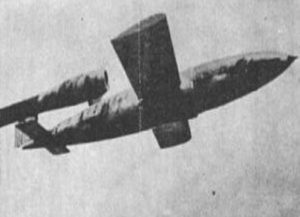
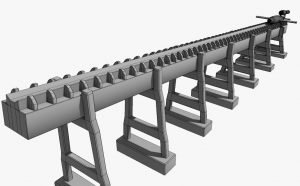 Every time I research one of the weapons used in war, I am more and more stunned by the hatred that brings the need to destroy one another. During World War II, Hitler continuously created…or rather had his scientists create newer, more powerful, and more devastating bombs. His V-1 missile, also known as the V-1 flying bomb, or in German: Vergeltungswaffe 1, meaning “Vengeance Weapon 1” became known to the Allies as the buzz bomb, or doodlebug. In Germany it was known as Kirschkern, or cherrystone, and as Maikäfer or maybug. It was an early cruise missile, and also the first production aircraft to use a pulsejet for power.
Every time I research one of the weapons used in war, I am more and more stunned by the hatred that brings the need to destroy one another. During World War II, Hitler continuously created…or rather had his scientists create newer, more powerful, and more devastating bombs. His V-1 missile, also known as the V-1 flying bomb, or in German: Vergeltungswaffe 1, meaning “Vengeance Weapon 1” became known to the Allies as the buzz bomb, or doodlebug. In Germany it was known as Kirschkern, or cherrystone, and as Maikäfer or maybug. It was an early cruise missile, and also the first production aircraft to use a pulsejet for power.
The V-1 was developed at Peenemünde Army Research Center by the Nazi German Luftwaffe during World War II. During initial development it was known by the codename “Cherry Stone.” It was first of the so-called “Vengeance weapons” (V-weapons or Vergeltungswaffen) series designed for terror bombing of London. As one of my readers, Greg (sorry, I don’t know his last name) pointed out to me, it was one of the V weapons…the V-3 to be exact that would ultimately cause the death of Joseph Kennedy, but that is a story for another day. The range of the V-1 missile was limited, and so the thousands of V-1 missiles launched into England were fired from launch facilities along the French (Pas-de-Calais) and Dutch coasts. The first V-1 was launched at London on 13 June 1944, one week after, and actually prompted by the successful Allied landings in Europe. At its peak, more than one hundred V-1s a day were fired at south-east England, 9,521 in total, decreasing in number as sites were overrun until October 1944, when the last V-1 site in range of Britain was overrun by Allied forces. After this, the V-1s were directed at the port of Antwerp and other targets in Belgium, with 2,448 V-1s being launched. The attacks stopped only a month before the war in Europe ended, when the last launch site in the Low Countries was overrun on March 29, 1945.
It took a V-1 about 15 minutes to travel from its launch pad in Calais, France to the heart of London…a distance of nearly 95 miles. Nearly 10,000 V-1s were launched from sites in Northern France over an 80 day period beginning in June 1944. Their targets included London, as well as other cities in southern England. At the peak of the bombing, more than 100 rockets were hitting Britain daily. Casualties climbed to 22,000 people, with more than 6,000 of them fatalities. Hitler hoped his new weapons would crush British morale, bringing 
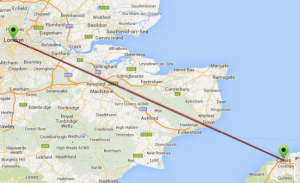 surrender. More V-1s would later be fired from inside Germany itself at Liege and the port of Antwerp. Hitler had underestimated the British, however. The British operated an arrangement of air defenses, including anti-aircraft guns and fighter aircraft, to intercept the bombs before they reached their targets as part of Operation Crossbow, while the launch sites and underground V-1 storage depots were targets of strategic bombings.
surrender. More V-1s would later be fired from inside Germany itself at Liege and the port of Antwerp. Hitler had underestimated the British, however. The British operated an arrangement of air defenses, including anti-aircraft guns and fighter aircraft, to intercept the bombs before they reached their targets as part of Operation Crossbow, while the launch sites and underground V-1 storage depots were targets of strategic bombings.
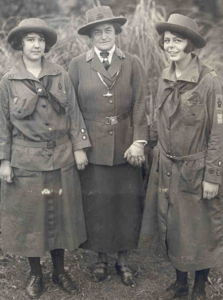 As a girl, I like many other girls became a Girl Scout. It was a group of girls having fun, while learning things and earning badges. The group was founded on March 12, 1912, and turns 105 years old today. The organization, called Girl Scouts, was founded in Savannah, Georgia by a woman named Juliette Gordon Low. She was born in 1860, and became a widow in 1905. She needed something…a cause. She had suffered through a bad marriage to a man who cheated on her and left most of his estate to his mistress. She wanted to help young women become self-sufficient…a cause borne out of her own experiences of feeling defined by the era’s roles for women, so she came up with the idea of a group that would teach young women about their worth and abilities. She first worked with a Scottish organization called Girl Guides and then founded the first American branch of the group in 1912, but she decided to break away and further develop her young women’s scouting association on her own. She soon changed the organization’s name to the Girl Scouts, and became the organization’s first president.
As a girl, I like many other girls became a Girl Scout. It was a group of girls having fun, while learning things and earning badges. The group was founded on March 12, 1912, and turns 105 years old today. The organization, called Girl Scouts, was founded in Savannah, Georgia by a woman named Juliette Gordon Low. She was born in 1860, and became a widow in 1905. She needed something…a cause. She had suffered through a bad marriage to a man who cheated on her and left most of his estate to his mistress. She wanted to help young women become self-sufficient…a cause borne out of her own experiences of feeling defined by the era’s roles for women, so she came up with the idea of a group that would teach young women about their worth and abilities. She first worked with a Scottish organization called Girl Guides and then founded the first American branch of the group in 1912, but she decided to break away and further develop her young women’s scouting association on her own. She soon changed the organization’s name to the Girl Scouts, and became the organization’s first president.
Low hoped to give her girls the opportunity to grow physically, mentally, emotionally, and even spiritually, Low 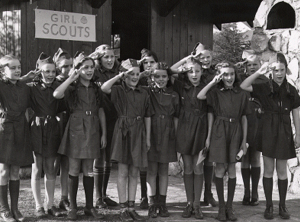 started the organization with just 18 girls in attendance at that first meeting. Low was an athlete, as well as an art lover. Her dream was to teach the girls that they could do anything. She wanted her girls to find out that they could help out in so many ways, and she definitely proved that. The Girl Scouts of America were very involved with the war effort back home during both World War I and World War II. They sold war bonds, collected peach pits for gas masks…peach pits were used as filters, worked in hospitals, and provided hands-on support to the country and the troops. Then, during the 1930s, when the Great Depression hit, the Girl Scouts again stepped up to the plate, collecting clothing and canned goods for the poor, making them quilts, providing meals for impoverished children, and helping out at hospitals.
started the organization with just 18 girls in attendance at that first meeting. Low was an athlete, as well as an art lover. Her dream was to teach the girls that they could do anything. She wanted her girls to find out that they could help out in so many ways, and she definitely proved that. The Girl Scouts of America were very involved with the war effort back home during both World War I and World War II. They sold war bonds, collected peach pits for gas masks…peach pits were used as filters, worked in hospitals, and provided hands-on support to the country and the troops. Then, during the 1930s, when the Great Depression hit, the Girl Scouts again stepped up to the plate, collecting clothing and canned goods for the poor, making them quilts, providing meals for impoverished children, and helping out at hospitals.
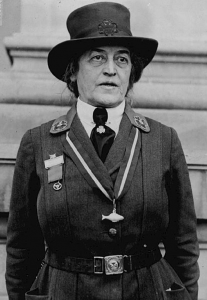
During my time in the Girl Scouts, I can’t say that I did anything that was as life changing as the Girl Scouts of days gone by, but I did enjoy my time as a scout. We learned many skills that earned us badges to wear on our sash, and some of those skills are still things I use today. The camaraderie that I felt as a Girl Scout was amazing. Some of the best friendships of my childhood were formed in those meetings. Those are years I will never forget, and I owe it all to Juliette Gordon Low, and her inspired ideas about what girls could be. Juliette Gordon Low died of breast cancer in 1927, in her Savannah, Georgia home. She was 66 years old. It was her request that she be buried in her Girl Scout uniform, because her years with the Girl Scouts were truly the happiest hears of her life. She also requested that a telegram from the National Board of Girl Scouts of the USA be placed in her pocket. It read, “You are not only the first Girl Scout, you are the best Girl Scout of them all.”
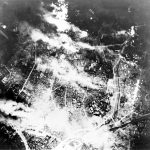 World War II had dragged on long enough. The Axis of Evil nations didn’t seem to care how many of their own people were killed, as long as victory was theirs…typical of any evil nation. It was time to put a stop to this, and the United States, along with the Allied Nations, could see no other solution to the problem, other than fighting fire with fire…literally. This would be the beginning of a horrible new kind of warfare. I’m sure they didn’t come to that decision lightly. While the Japanese were our enemies, the civilian people didn’t really have much say in what they did. Nevertheless, in a war, sometimes civilians are killed. Collateral damage, they call it. It’s a term for deaths, injuries, or other damage inflicted on an unintended target. In American military terminology, it is used for the incidental killing or wounding of non-combatants or damage to non-combatant property during an attack on a legitimate military target. Knowing that the loss of civilian lives is considered “acceptable” in a war, doesn’t make it easy to live with.
World War II had dragged on long enough. The Axis of Evil nations didn’t seem to care how many of their own people were killed, as long as victory was theirs…typical of any evil nation. It was time to put a stop to this, and the United States, along with the Allied Nations, could see no other solution to the problem, other than fighting fire with fire…literally. This would be the beginning of a horrible new kind of warfare. I’m sure they didn’t come to that decision lightly. While the Japanese were our enemies, the civilian people didn’t really have much say in what they did. Nevertheless, in a war, sometimes civilians are killed. Collateral damage, they call it. It’s a term for deaths, injuries, or other damage inflicted on an unintended target. In American military terminology, it is used for the incidental killing or wounding of non-combatants or damage to non-combatant property during an attack on a legitimate military target. Knowing that the loss of civilian lives is considered “acceptable” in a war, doesn’t make it easy to live with.
The prospect was sickening, but something had to be done. So, on March 10, 1945, 300 American bombers 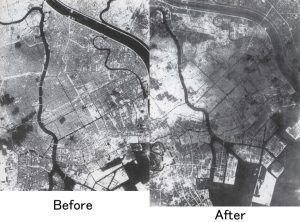 continue to drop almost 2,000 tons of incendiaries on Tokyo, Japan, in a mission that had begun the previous day. The attack destroyed large portions of the Japanese capital and killed 100,000 civilians. Early in the morning on March 10th, the B-29s dropped their bombs of napalm and magnesium incendiaries over the packed residential districts along the Sumida River in eastern Tokyo. The resulting inferno quickly engulfed Tokyo’s wooden residential structures, and the subsequent firestorm replaced oxygen with lethal gases, superheated the atmosphere, and caused hurricane-like winds that blew a wall of fire across the city. The majority of the 100,000 who perished died from carbon monoxide poisoning and the sudden lack of oxygen, but others died horrible deaths within the firestorm, such as those who attempted to find protection in the Sumida River and were boiled alive, or those who were trampled to death in the rush to escape the burning city. As a result of the attack, 10 square miles of eastern Tokyo were entirely obliterated, and an estimated 250,000 buildings were destroyed. When I think about the loss of life brought on by a complete lack of the Japanese government to surrender when they should have.
continue to drop almost 2,000 tons of incendiaries on Tokyo, Japan, in a mission that had begun the previous day. The attack destroyed large portions of the Japanese capital and killed 100,000 civilians. Early in the morning on March 10th, the B-29s dropped their bombs of napalm and magnesium incendiaries over the packed residential districts along the Sumida River in eastern Tokyo. The resulting inferno quickly engulfed Tokyo’s wooden residential structures, and the subsequent firestorm replaced oxygen with lethal gases, superheated the atmosphere, and caused hurricane-like winds that blew a wall of fire across the city. The majority of the 100,000 who perished died from carbon monoxide poisoning and the sudden lack of oxygen, but others died horrible deaths within the firestorm, such as those who attempted to find protection in the Sumida River and were boiled alive, or those who were trampled to death in the rush to escape the burning city. As a result of the attack, 10 square miles of eastern Tokyo were entirely obliterated, and an estimated 250,000 buildings were destroyed. When I think about the loss of life brought on by a complete lack of the Japanese government to surrender when they should have.
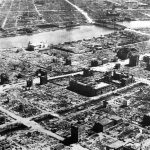
This type of bombing was known as area bombing, and was designed to break Japanese morale and force a surrender. I would imagine that morale was seriously broken after such devastating loss of life and property. The firebombing of Tokyo was the first major firebombing operation of this kind against Japan. Over the next nine days, United States bombers flew similar missions against Nagoya, Osaka, and Kobe. Then in August, United States atomic attacks against Hiroshima and Nagasaki finally forced the Japanese surrender. It was an ugly way to have for fight a war, but the Japanese did not seem to care if their own citizens were sacrificed for their evil cause. All they cared about was winning. Thankfully, they didn’t do that either.

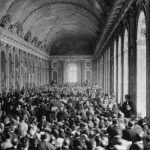 One would expect that after being defeated in a war, it would be understood that you don’t go up against the same adversary again, but apparently this concept was lost on Adolf Hitler. We all know who Hitler was, and that he was bent on taking over the world. There were things about him that had the people of Germany fooled into thinking that he was going to be a great leader, until his Nazi swastika became the symbol of hate and Anti-Semitism. In late June 1914, Archduke Franz Ferdinand of Austria was assassinated by a Serbian nationalist in Sarajevo, Bosnia. An escalation of threats and mobilization orders followed the incident, leading by mid-August to the outbreak of World War I, which pitted Germany, Austria-Hungary and the Ottoman Empire, called the Central Powers, against Great Britain, France, Russia, Italy and Japan, the Allied Powers. The Allies were joined after 1917 by the United States. The Great War, as it was then known, went on for four long years, and saw unprecedented levels of death and destruction, due mostly to grueling trench warfare and the introduction of modern weaponry such as machine guns, tanks and chemical weapons. By the time World War I ended in the defeat of the Central Powers in November 1918, more than 9 million soldiers had been killed and 21 million more were wounded. It makes me cringe to think of the good men lost because of hatred.
One would expect that after being defeated in a war, it would be understood that you don’t go up against the same adversary again, but apparently this concept was lost on Adolf Hitler. We all know who Hitler was, and that he was bent on taking over the world. There were things about him that had the people of Germany fooled into thinking that he was going to be a great leader, until his Nazi swastika became the symbol of hate and Anti-Semitism. In late June 1914, Archduke Franz Ferdinand of Austria was assassinated by a Serbian nationalist in Sarajevo, Bosnia. An escalation of threats and mobilization orders followed the incident, leading by mid-August to the outbreak of World War I, which pitted Germany, Austria-Hungary and the Ottoman Empire, called the Central Powers, against Great Britain, France, Russia, Italy and Japan, the Allied Powers. The Allies were joined after 1917 by the United States. The Great War, as it was then known, went on for four long years, and saw unprecedented levels of death and destruction, due mostly to grueling trench warfare and the introduction of modern weaponry such as machine guns, tanks and chemical weapons. By the time World War I ended in the defeat of the Central Powers in November 1918, more than 9 million soldiers had been killed and 21 million more were wounded. It makes me cringe to think of the good men lost because of hatred.
In July 1919, just eight months after the end of World War I, the Treaty of Versailles was signed, calling for stiff war reparation payments and other punishing peace terms for a defeated Germany. Having been forced to sign the treaty, the German delegation to the peace conference indicated its attitude by breaking the ceremonial pen. In my mind, that was indicative of what was to come. They felt like they shouldn’t have had to surrender or sign such an agreement, and they were telling the world that at some point they would break that treaty. As dictated by the Treaty of Versailles, Germany’s military forces were reduced to insignificance and the Rhineland, along the western border of Germany, was to be demilitarized. Nazi leader Adolf Hitler, well known for his hatred of authority, and for his lack of good sense as it turns out, would violate the Treaty of Versailles and the Locarno Pact by sending German military forces into the Rhineland just four years later.
By 1923, Adolf Hitler and the Nazi Party had seized full power in Germany, removing the rights of the people to have any say in their lives or in government. Hitler promised vengeance against the Allied nations that had 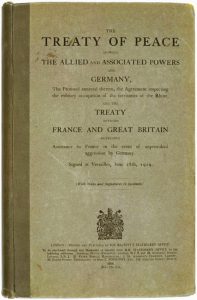
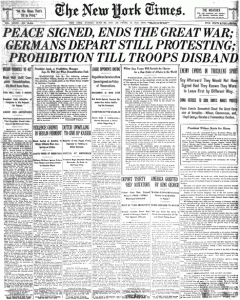 forced the Treaty of Versailles on the German people. In my opinion, the German people had nothing to do with it. The problem with the Treaty of Versailles and the Locarno Pact was Hitler’s on dislike of authority. In 1935, Hitler unilaterally canceled the military clauses of the treaty and in March 1936 denounced the Locarno Pact and began the remilitarizing of the Rhineland. Two years later, Nazi Germany burst out of its territories, absorbing Austria and portions of Czechoslovakia. In 1939, Hitler invaded Poland, leading to the outbreak of World War II in Europe. Hitler would be defeated in World War II, just as he was in World War I, and his suicide and complete show of cowardice would prove that he was not only hateful, but incredibly stupid as well.
forced the Treaty of Versailles on the German people. In my opinion, the German people had nothing to do with it. The problem with the Treaty of Versailles and the Locarno Pact was Hitler’s on dislike of authority. In 1935, Hitler unilaterally canceled the military clauses of the treaty and in March 1936 denounced the Locarno Pact and began the remilitarizing of the Rhineland. Two years later, Nazi Germany burst out of its territories, absorbing Austria and portions of Czechoslovakia. In 1939, Hitler invaded Poland, leading to the outbreak of World War II in Europe. Hitler would be defeated in World War II, just as he was in World War I, and his suicide and complete show of cowardice would prove that he was not only hateful, but incredibly stupid as well.
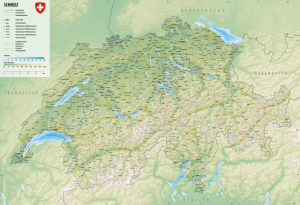 I think most of us know that a conscientious objector is a person who feels strongly about not killing…even in a war. However, there are actually entire countries who believe that way…or almost. The most well known country to claim neutrality is Switzerland. Other countries to claim non-interventionist stances include Ireland, Austria, and Costa Rica, but Switzerland is remains the oldest and most respected of them all. In fact, Switzerland has been in a state of perpetual neutrality for centuries. This state of neutrality does not mean they do not have an army, because they do. The country maintains an army for defense purposes and requires part-time military service from all males between the ages of 18 and 34. So how did this state of perpetual neutrality come about, and what does it mean exactly?
I think most of us know that a conscientious objector is a person who feels strongly about not killing…even in a war. However, there are actually entire countries who believe that way…or almost. The most well known country to claim neutrality is Switzerland. Other countries to claim non-interventionist stances include Ireland, Austria, and Costa Rica, but Switzerland is remains the oldest and most respected of them all. In fact, Switzerland has been in a state of perpetual neutrality for centuries. This state of neutrality does not mean they do not have an army, because they do. The country maintains an army for defense purposes and requires part-time military service from all males between the ages of 18 and 34. So how did this state of perpetual neutrality come about, and what does it mean exactly?
The earliest attempt by Switzerland, at neutrality came in 1515 when the Swiss Confederacy suffered a devastating loss to the French at the Battle of Marignano. After that, the country abandoned any thought of expanding it’s borders in an attempt to avoid future conflict. All this was done in the interest of self-preservation. The Napoleonic Wars, however, truly sealed Switzerland’s place as a neutral nation. Switzerland was invaded by France in 1798 and was later made a satellite of Napoleon Bonaparte’s empire, forcing it to compromise its neutrality. Napoleon was defeated, and the major European powers decided that a neutral Switzerland would provide a much needed buffer zone between France and Austria. It was assumed that their neutrality would bring stability to the region. Then during the 1815 Congress of Vienna, a declaration was signed affirming Switzerland’s state of “perpetual neutrality” within the international community. In 1920, the newly formed League of Nations officially recognized Swiss neutrality and established its headquarters in Geneva.
Switzerland’s state of perpetual neutrality has not been without it’s challenges. In World War I, it mobilized its army and accepted refugees but also refused to take sides militarily. An even bigger challenge to Switzerland’s neutrality came in World War II, when the country was surrounded by Axis powers. Switzerland continued in its neutral stance, saying that they would retaliate in the event of an invasion, but would not enter the war. Nevertheless, they continued to trade with Nazi Germany, a decision that caused controversy after the war ended.
After World War II, Switzerland has been active in international affairs by siding with humanitarian initiatives, while maintaining its neutrality when it came to military issues. 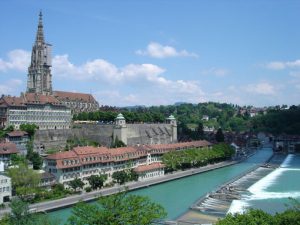 Switzerland refuses to join NATO or the European Union, and only joined the United Nations in 2002. In my opinion it might as well have stayed out of the United Nations entirely. I understand the desire to stay neutral and out of wars, but to me it seems a little bit like walking the fence. They want the good that’s offered without having to hold the evil nations accountable for their actions. I realize the Switzerland has done things for the rest of the world, but it still seems like a bit of a cop out when their trade is not affected because they refuse to argue the evil that some nations do.
Switzerland refuses to join NATO or the European Union, and only joined the United Nations in 2002. In my opinion it might as well have stayed out of the United Nations entirely. I understand the desire to stay neutral and out of wars, but to me it seems a little bit like walking the fence. They want the good that’s offered without having to hold the evil nations accountable for their actions. I realize the Switzerland has done things for the rest of the world, but it still seems like a bit of a cop out when their trade is not affected because they refuse to argue the evil that some nations do.
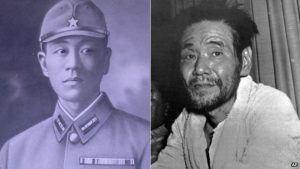 These days, lots of people have considered living off the grid. It’s almost the latest thing. Most of them really just want to do away with the bills that go along with being on the grid…water, electric, gas etc, but some of them are really wanting to lead a disconnected life. They want to shut off the phone, television, and computer, and just enjoy nature. To me, that sounds like fun for about a day…but then I am more a child of the age of technology than even my kids and grandkids are sometimes, and that’s saying something, because they are technological people, in one way or another. I have to wonder how the off the grid people would feel about it, if they had been Shoichi Yokoi.
These days, lots of people have considered living off the grid. It’s almost the latest thing. Most of them really just want to do away with the bills that go along with being on the grid…water, electric, gas etc, but some of them are really wanting to lead a disconnected life. They want to shut off the phone, television, and computer, and just enjoy nature. To me, that sounds like fun for about a day…but then I am more a child of the age of technology than even my kids and grandkids are sometimes, and that’s saying something, because they are technological people, in one way or another. I have to wonder how the off the grid people would feel about it, if they had been Shoichi Yokoi.
At this point, I’m sure that you are wondering who Shoichi Yokoi is and what was going on with him that made him such an off the grid type, so I’ll tell you. Shoichi Yokoi was a Japanese sergeant, from World War II. Shoichi was stationed on Guam, which had become a United States territory in 1898. In 1941, during World War II, the Japanese attacked Guam and captured it. The 200 square mile island, located in the western Pacific Ocean remained in Japanese Hands for three years. Then, the United States attacked and retook the island. As the Japanese forces retreated and surrendered, Yokoi made the decision not to surrender, and he went into hiding in the Jungle. He dug a tunnel, that would be his home while he was in hiding. Yokoi, who had been a tailor’s apprentice before being drafted in 1941, made clothing from the fibers of wild hibiscus plants and survived on a diet of coconuts, breadfruit, papayas, snails, eels and rats. “We Japanese soldiers were told to prefer death to the disgrace of getting captured alive.” While living in the jungle, Yokoi carved survival tools and for the next three decades waited for the return of the Japanese and his next orders…three decades!!!
Somehow, this man was so far off the grid that he had no idea what was going on in the world for almost three decades, and he assumed that World War II was still going on. He spoke to no one. He hid from anyone who might have come near him. Then, he slipped up…a good thing, as it would turn out to be. After 28 years of hiding in the jungles of Guam, local farmers discovered Shoichi Yokoi hiding in the jungle. I’m sure he was totally shocked to find out that he was the only one in the world still fighting World War II!! After he was discovered on January 24, 1972, he was finally discharged and sent home to Japan, where he was hailed as a national hero. I guess Shoichi must have grown to love Guam, because when he married, he and his new bride 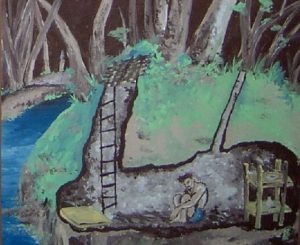
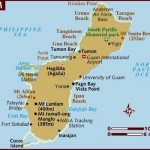 returned to Guam for their honeymoon. Shoichi went on to live a long life, and passed away on September 22, 1997 at the age of 82. The people of Guam and the governments of the United States and Japan must have though that his story was so amazing that his handcrafted survival tools and threadbare uniform are now on display in the Guam Museum in Agana. Shoichi might have been an enemy of the United States, but I can’t help but think that he must have been a very faithful soldier, to have held out that long.
returned to Guam for their honeymoon. Shoichi went on to live a long life, and passed away on September 22, 1997 at the age of 82. The people of Guam and the governments of the United States and Japan must have though that his story was so amazing that his handcrafted survival tools and threadbare uniform are now on display in the Guam Museum in Agana. Shoichi might have been an enemy of the United States, but I can’t help but think that he must have been a very faithful soldier, to have held out that long.

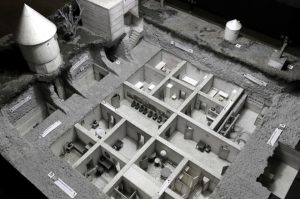 I read yesterday, that Adolf Hitler went into his underground bunker, known as the Führerbunker, with his mistress, Eva Braun on January 16, 1945. It was a coward’s move, so as not to have to face the Russians when they marched into town. He left his men to finish out the war in a losing battle, and when they wanted to surrender, they were rewarded with death. They were considered cowards, and yet Hitler made his last trip above ground on April 20, 1945, his 56th birthday. He took that opportunity, in the ruined garden of the Reich Chancellery, to award the Iron Cross to boy soldiers of the Hitler Youth, and then he retreated back to the safety of his bunker. On April 28th, Hitler learned that Reichsführer, SS Heinrich Himmler, who had left Berlin on April 20th was trying to discuss surrender terms with the Western Allies through Count Folke Bernadotte. To Hitler this was treason, and he was enraged. He ordered Himmler’s arrest. He also had Hermann Fegelein, Himmler’s SS representative at Hitler’s Headquarters in Berlin, shot. Those men were doing their best to stay alive, and Hitler sat in the safety of his bunker calling them traitors and cowards. Hitler’s bunker, while not elegant by any standard, was quite comfortable. He and Eva were well protected until the day they took their own lives on April 30, 1945…one day after their April 29th
I read yesterday, that Adolf Hitler went into his underground bunker, known as the Führerbunker, with his mistress, Eva Braun on January 16, 1945. It was a coward’s move, so as not to have to face the Russians when they marched into town. He left his men to finish out the war in a losing battle, and when they wanted to surrender, they were rewarded with death. They were considered cowards, and yet Hitler made his last trip above ground on April 20, 1945, his 56th birthday. He took that opportunity, in the ruined garden of the Reich Chancellery, to award the Iron Cross to boy soldiers of the Hitler Youth, and then he retreated back to the safety of his bunker. On April 28th, Hitler learned that Reichsführer, SS Heinrich Himmler, who had left Berlin on April 20th was trying to discuss surrender terms with the Western Allies through Count Folke Bernadotte. To Hitler this was treason, and he was enraged. He ordered Himmler’s arrest. He also had Hermann Fegelein, Himmler’s SS representative at Hitler’s Headquarters in Berlin, shot. Those men were doing their best to stay alive, and Hitler sat in the safety of his bunker calling them traitors and cowards. Hitler’s bunker, while not elegant by any standard, was quite comfortable. He and Eva were well protected until the day they took their own lives on April 30, 1945…one day after their April 29th 
 marriage. Their death came by cyanide poisoning, with Hitler’s accompanied by a self inflicted gunshot wound to the head. They did not want to face the possibility of a trial for the many war crimes he was responsible for.
marriage. Their death came by cyanide poisoning, with Hitler’s accompanied by a self inflicted gunshot wound to the head. They did not want to face the possibility of a trial for the many war crimes he was responsible for.
In what was proving to be a crumbling empire, Hitler’s death camp soldiers knew they too, were in trouble, the day after he went underground. On January 17, 1945, the Russians were approaching Auschwitz. The decision was made to evacuate most of its population and send them on a death march. It was the largest and the most notorious of the death marches. Just nine days before the Soviets arrived at the death camp at Auschwitz, the SS marched nearly 60,000 prisoners out of the camp toward Loslau, 39 miles away. There, they were put on freight trains to other camps. Approximately 15,000 prisoners died on the way, which is why it was called a death march. Loslau recorded a freezing -4°F and lower at the time the prisoners were arriving. Residents tried to help the prisoners, and many prisoners regained freedom between Auschwitz and Loslau, as the residents helped them escape. The prisoners who were left at the camp were liberated on 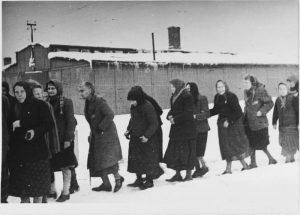
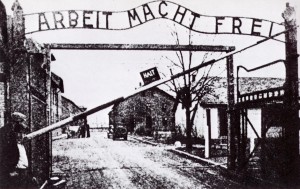 January 27, 1945, which is a day now commemorated as International Holocaust Remembrance Day. In years after the Holocaust, survivors, such as Primo Levi, Viktor Frankl, and Elie Wiesel, wrote memoirs of their experiences in Auschwitz, and the camp became a dominant symbol of the Holocaust. In 1947, Poland founded the Auschwitz-Birkenau State Museum on the site of Auschwitz I and II, and in 1979, it was named a UNESCO World Heritage Site.
January 27, 1945, which is a day now commemorated as International Holocaust Remembrance Day. In years after the Holocaust, survivors, such as Primo Levi, Viktor Frankl, and Elie Wiesel, wrote memoirs of their experiences in Auschwitz, and the camp became a dominant symbol of the Holocaust. In 1947, Poland founded the Auschwitz-Birkenau State Museum on the site of Auschwitz I and II, and in 1979, it was named a UNESCO World Heritage Site.

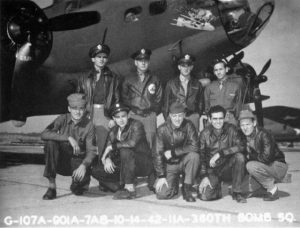 Every war has its casualties…it is an inevitable part of battle. World War II was no different, and in fact it was the deadliest war in world history, with casualties between 40,000,000 and 72,000,000. On average, 6,600 American servicemen died per month during World War II, about 220 a day. By the end of the war, over 40,000 airmen were killed in combat theatres and another 18,000 wounded. Some 12,000 missing men were declared dead, including a number liberated by the Soviets but never returned. More than 41,000 were captured, half of the 5,400 held by the Japanese died in captivity, compared with one tenth in German hands. As with any part of the war, being an airman in World War II was simply a very dangerous business.
Every war has its casualties…it is an inevitable part of battle. World War II was no different, and in fact it was the deadliest war in world history, with casualties between 40,000,000 and 72,000,000. On average, 6,600 American servicemen died per month during World War II, about 220 a day. By the end of the war, over 40,000 airmen were killed in combat theatres and another 18,000 wounded. Some 12,000 missing men were declared dead, including a number liberated by the Soviets but never returned. More than 41,000 were captured, half of the 5,400 held by the Japanese died in captivity, compared with one tenth in German hands. As with any part of the war, being an airman in World War II was simply a very dangerous business.
Over the years of World War II, there were many stories of men falling from their planes either from attack or accident. I’m sure some were just stories, but this is a true story. Staff Sergeant Alan Magee was born on January 13, 1919 in Plainfield, New Jersey, the youngest of six children of Resue and Doretta (Winn) Magee. Alan grew to be a short 5’7″ tall. That is short for a man, but slightly tall for a ball turret gunner on a B-17 bomber. Like many men, Alan joined the service right after the attack on Pearl Harbor. He was assigned as a ball turret gunner with the 303rd Bomb Group, 360th Squadron stationed at RAF Molesworth, which is a Royal Air Force station located near Molesworth, Cambridgeshire, England.
At 5’7″ inches, Magee was barely small enough to fit in the B-17’s ball turret. The ball turret was a cramped, donut shaped plastic glass and metal turret on the belly of the bomber. It was such a tight fit that a gunner’s knees were practically against his chest. Magee had to leave his parachute on the deck of the four engine Flying Fortress. That fact would prove to be detrimental. On January 3, 1943, Magee was assigned to a B-17, nicknamed “Snap! Crackle! Pop!” They were on a bombing run during the daytime over Saint Nazaire, France, also known at “Flack City,” when German fighters shot off a part of the right wing, causing the plane to enter a deadly spin. This was Magee’s seventh mission. That was an amazing feat in and of itself, because the life expectancy of a ball turret gunner in World War II was 12 minutes. It was really considered a suicide position on the plane. Oddly too, Magee was one of the oldest members of the 10 man crew at 24 years. The pilot, Captain Arthur Adams, was only 19, and this was only his third combat mission.
Magee was wounded in the attack, but managed to escape the ball turret, scrambling back into the cabin for his parachute. The only problem was that his parachute had been damaged and was totally useless, so having no other choice, Magee leapt from the spiraling plane without his parachute, losing consciousness rapidly because of the altitude. During his fall from the plane, Magee asked God to save his life. “I don’t wish to die because I know nothing of life,” was his appeal to God. Then, he totally lost consciousness and crashed through the glass roof of the Saint Nazaire train station. Eyewitnesses watched in horror as Magee came through the skylight. When he regained consciousness, Magee said to his captors: “Thank God I’m alive.” Magee’s injuries included 28 shrapnel wounds. A lung and kidney were hit. His nose and an eye were ripped open. His broken bones included his right leg and ankle. A right arm was nearly severed. The Germans decided that anyone who could miraculously survive such a fall deserved “real special attention.” It is thought that he fell over four miles before crashing through the glass roof. Some said they thought that the glass roof lessened Magee’s impact, and rescuers found him still alive on the floor of the station. It is my belief that God sent His angels to break the fall, because a 20,000 foot into a soft field can be fatal, so it is a miracle that he fell through a glass roof onto a concrete floor and lived. Magee regained consciousness in the first aid station before being transferred to the local hospital. “I owe the German military doctor who treated me a debt of gratitude,” said Magee. “He told me, ‘We are enemies, but I am first a doctor and I will do my best to save your arm.’” The doctor saved Magee’s arm and tended his other injuries, but unfortunately, Magee never found out the doctor’s name, so he couldn’t thank him. Staff Sargent Magee was taken as a POW and given continued medical treatment for his injuries by his captors. Magee was rescued in May 1945, and received the Air Medal for meritorious conduct and the Purple Heart. When the war was over, Magee got his pilot’s license and enjoyed flying. He worked a variety of jobs in the airline industry, and retired in 1979. He then moved to Northern New Mexico.
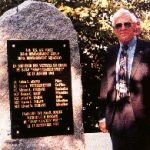
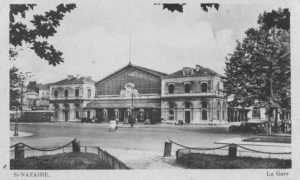 The people of Saint Nazaire, France honored Magee and the crew of his bomber on January 3rd, 1993 by erecting a six foot tall memorial to them. Alan Magee passed away in San Angelo, Texas on December 20th, 2003, at 84 from stroke and kidney failure. With the German doctors’ help, Magee fully recovered. Magee later hiked and backpacked and “led a pretty good life.” Two of his crewmen also survived. In all, 75 airmen died, seven U.S. planes were destroyed and 47 were damaged that day.
The people of Saint Nazaire, France honored Magee and the crew of his bomber on January 3rd, 1993 by erecting a six foot tall memorial to them. Alan Magee passed away in San Angelo, Texas on December 20th, 2003, at 84 from stroke and kidney failure. With the German doctors’ help, Magee fully recovered. Magee later hiked and backpacked and “led a pretty good life.” Two of his crewmen also survived. In all, 75 airmen died, seven U.S. planes were destroyed and 47 were damaged that day.
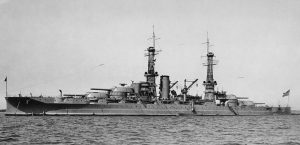 Most people know that the USS Arizona was one of the ships that was bombed when the Japanese attacked Pearl Harbor on December 7, 1941. The USS Arizona’s sinking took with it, 1,177 men…almost half of the total of 2,403 people killed at Pearl Harbor. The Arizona was one of 20 American ships and more than 300 airplanes lost that day. We know that the attack woke the sleeping giant that is the United States, and we joined World War II with the Allies to stop the tyranny that was Japan and later Germany and Italy. Most people know that the Allies were successful in World War II, and after four long years and the loss of over 400,000 lives, the war was over. There are a few facts about the USS Arizona that many people might not know, however.
Most people know that the USS Arizona was one of the ships that was bombed when the Japanese attacked Pearl Harbor on December 7, 1941. The USS Arizona’s sinking took with it, 1,177 men…almost half of the total of 2,403 people killed at Pearl Harbor. The Arizona was one of 20 American ships and more than 300 airplanes lost that day. We know that the attack woke the sleeping giant that is the United States, and we joined World War II with the Allies to stop the tyranny that was Japan and later Germany and Italy. Most people know that the Allies were successful in World War II, and after four long years and the loss of over 400,000 lives, the war was over. There are a few facts about the USS Arizona that many people might not know, however.
Twenty three sets of brothers died aboard USS Arizona. In all there were 37 confirmed pairs or trios of brothers assigned to the ship. Of the 77 men in those sets, 62 were killed. Only one full set of brothers survived. Kenneth and Russell Warriner survived because Kenneth was away at flight school in San Diego, and Russell, while badly wounded, lived. Also on board were father and son, Thomas Free and his son William who served and were killed aboard the Arizona that day. While no regulation exists, US officials discouraged siblings serving on the same ship after the Pearl Harbor attack. In addition to these men who died, the USS Arizona’s entire band, all 21 members, known as US Navy Band Unit (NBU) 22, were lost in the attack. Most of its members were up on deck preparing to play music for the daily flag raising ceremony when the attack began. They instantly moved to man their battle positions beneath the ship’s gun turret. It was the only time in American history that an entire military band died in action. In the years following the attack, and following the decision to leave the dead in the USS Arizona, it was decided that a memorial should be placed there. That is a known fact, but what I didn’t know was that in March 1961, Elvis Presley, who had recently finished a two year stint in the US Army, performed a benefit concert at 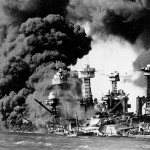
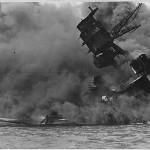 Pearl Harbor’s Block Arena that raised over $50,000. That was more than 10 percent of the USS Arizona Memorial’s final cost. The monument was officially dedicated on May 30, 1962.
Pearl Harbor’s Block Arena that raised over $50,000. That was more than 10 percent of the USS Arizona Memorial’s final cost. The monument was officially dedicated on May 30, 1962.
One of the most surprising facts about the Arizona, however, is related to the fuel. The day before the Pearl Harbor attack, the Arizona had taken on a full load of fuel…nearly 1.5 million gallons, because it was set to make a trip to the mainland later that month. When the Japanese bombers attacked, that fuel played a major part in the explosions and raging fire that followed the bombing. After the fires were put out, there were 500,000 gallons of fuel left in the ship. Now, 75 years later, the Arizona continues to spill up to 9 quarts of oil into the harbor each day. In the mid-1990s, concerns for the environment led the National Park Service to commission a series of site studies to determine the long term effects of the oil leakage. Some scientists have warned of a possible “catastrophic” eruption of oil from the wreckage, which they believe would cause extensive damage to the Hawaiian shoreline and disrupt US naval functions in the area. They continue to monitor the deterioration of the wreck site but are reluctant to perform extensive repairs or modifications due to the Arizona’s role as a “war grave.” In fact, the oil that often coats the surface of the water surrounding the ship has added an emotional gravity for many who visit the memorial and is sometimes referred to as the “tears of the Arizona” or “black tears.”
As surprising as that is, there is still one more fact that many people didn’t know. The bonds between the crewmembers of Arizona have lasted far beyond the loss of the ship on December 7, 1941. Since 1982, the US Navy has allowed survivors of USS Arizona to be interred in the ship’s wreckage upon their deaths. After a full military funeral at the Arizona memorial, the cremated remains are placed in an urn and then deposited by divers beneath one of the Arizona’s gun turrets. More than 30 Arizona crewmen who survived Pearl Harbor 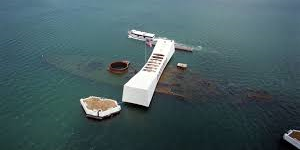 have chosen the ship as their final resting place. Crewmembers who served on the ship prior to the attack may have their ashes scattered above the wreck site, and those who served on other vessels stationed at Pearl Harbor on December 7, 1941, may have their ashes scattered above their former ships. As of November 2011, only 18 of the 355 crewmen who survived the bombing of USS Arizona are known to be alive. I knew that the Pearl Harbor attack had a deep impact on the lives of the survivors, but I guess I didn’t fully understand that it was a life changing event, and it would never really leave them.
have chosen the ship as their final resting place. Crewmembers who served on the ship prior to the attack may have their ashes scattered above the wreck site, and those who served on other vessels stationed at Pearl Harbor on December 7, 1941, may have their ashes scattered above their former ships. As of November 2011, only 18 of the 355 crewmen who survived the bombing of USS Arizona are known to be alive. I knew that the Pearl Harbor attack had a deep impact on the lives of the survivors, but I guess I didn’t fully understand that it was a life changing event, and it would never really leave them.
 It’s always fun to find out that you are related to someone who is famous, and for me, it has been common knowledge for all of my life. The Spencer side of my family is full of aristocracy. Some are princes and princesses, and even future kings, and others were great strategists, like Winston Leonard Spencer-Churchill, who is my 15th cousin once removed. You will notice the hyphen, and while it isn’t in his name, it is nevertheless, correct. He was a product of grandparents who merged two wealthy family names, when his 4th great grandfather, Charles Spencer married Ann Churchill and they hyphenated the names. Later, family members either used the traditional Spencer name, such as Diana Spencer’s line, or they used the Churchill name, as Winston Churchill’s line did, even though they continued the Spencer part of the name in his line. People have often thought it was his middle name, but that is not so. I don’t know if they used the hyphen back then, but the names were both last names.
It’s always fun to find out that you are related to someone who is famous, and for me, it has been common knowledge for all of my life. The Spencer side of my family is full of aristocracy. Some are princes and princesses, and even future kings, and others were great strategists, like Winston Leonard Spencer-Churchill, who is my 15th cousin once removed. You will notice the hyphen, and while it isn’t in his name, it is nevertheless, correct. He was a product of grandparents who merged two wealthy family names, when his 4th great grandfather, Charles Spencer married Ann Churchill and they hyphenated the names. Later, family members either used the traditional Spencer name, such as Diana Spencer’s line, or they used the Churchill name, as Winston Churchill’s line did, even though they continued the Spencer part of the name in his line. People have often thought it was his middle name, but that is not so. I don’t know if they used the hyphen back then, but the names were both last names.
Churchill was born to Lord Randolph Spencer and his wife Jennie Jerome, on November 30, 1874. They were members of a prestigious family with a long history of military service and upon his father’s death in 1895, 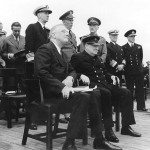 Winston joined the British Fourth Hussars. During the next five years, Winston Churchill enjoyed an illustrious military career, serving in India, the Sudan, and South Africa, and distinguishing himself several times in battle. In 1899, he resigned his commission to concentrate on his literary and political career and in 1900 was elected to Parliament as a Conservative MP from Oldham. In 1904, he began serving in a number of important posts before being appointed Britain’s First Lord of the Admiralty in 1911. Churchill foresaw a war that would bring with it a need for a navy that was ready, and well thought out strategies that would bring victory, and he worked to bring such a British Navy into existence. Churchill was a born strategist.
Winston joined the British Fourth Hussars. During the next five years, Winston Churchill enjoyed an illustrious military career, serving in India, the Sudan, and South Africa, and distinguishing himself several times in battle. In 1899, he resigned his commission to concentrate on his literary and political career and in 1900 was elected to Parliament as a Conservative MP from Oldham. In 1904, he began serving in a number of important posts before being appointed Britain’s First Lord of the Admiralty in 1911. Churchill foresaw a war that would bring with it a need for a navy that was ready, and well thought out strategies that would bring victory, and he worked to bring such a British Navy into existence. Churchill was a born strategist.
Winston Churchill’s military leadership took quite a blow during World War I, when he was held responsible for the disastrous Dardanelles and Gallipoli campaigns in 1915, and he was excluded from the war coalition government. He resigned his commission, and volunteered to command an infantry battalion in France. In 1917, Churchill returned to politics. He became a cabinet member of the Liberal government of Lloyd George, a move that I suspect he would regret. From 1919 to 1921, he was secretary of state for war. Then, in 1924 he returned to the Conservative Party, where two years later he played a leading role in the defeat of the General Strike of 1926. Out of office from 1929 to 1939, Churchill issued unheeded warnings of the threat of German 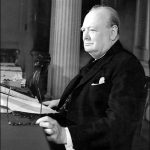 and Japanese attacks. After the outbreak of World War II in Europe, Churchill was called back to his post as First Lord of the Admiralty and eight months later replaced Neville Chamberlain, an ineffective military leader, as prime minister of a new coalition government. In the first year of his administration, Britain stood alone against Nazi Germany, but Churchill promised his country and the world that the British people would “never surrender.” He rallied the British people to a strong resistance and expertly orchestrated Franklin D Roosevelt and Joseph Stalin into an alliance that eventually crushed the Axis. Churchill proved himself to be the best military leader Britain could possibly have had at a time when he was desperately needed. Today would have been Winston Spencer Churchill’s 142nd birthday.
and Japanese attacks. After the outbreak of World War II in Europe, Churchill was called back to his post as First Lord of the Admiralty and eight months later replaced Neville Chamberlain, an ineffective military leader, as prime minister of a new coalition government. In the first year of his administration, Britain stood alone against Nazi Germany, but Churchill promised his country and the world that the British people would “never surrender.” He rallied the British people to a strong resistance and expertly orchestrated Franklin D Roosevelt and Joseph Stalin into an alliance that eventually crushed the Axis. Churchill proved himself to be the best military leader Britain could possibly have had at a time when he was desperately needed. Today would have been Winston Spencer Churchill’s 142nd birthday.

